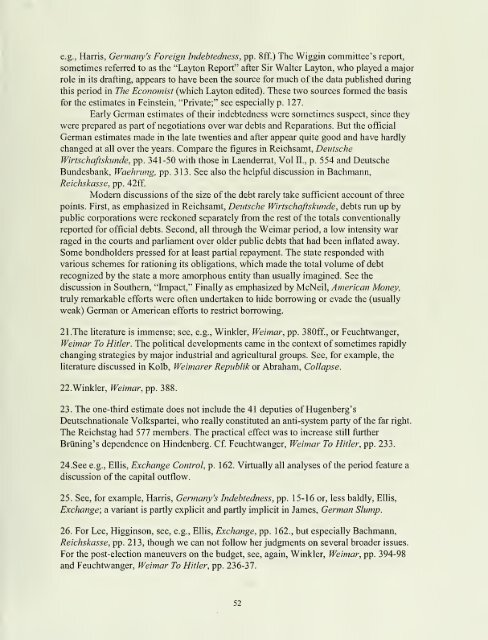Made in Germany : the German currency crisis of July 1931
Made in Germany : the German currency crisis of July 1931
Made in Germany : the German currency crisis of July 1931
You also want an ePaper? Increase the reach of your titles
YUMPU automatically turns print PDFs into web optimized ePapers that Google loves.
e.g., Harris, <strong><strong>German</strong>y</strong>'s Foreign Indebtedness, pp. 8ff.) The Wigg<strong>in</strong> committee's report,<br />
sometimes referred to as <strong>the</strong> "Layton Report" after Sir Walter Layton, who played a major<br />
role <strong>in</strong> its draft<strong>in</strong>g, appears to have been <strong>the</strong> source for much <strong>of</strong> <strong>the</strong> data published dur<strong>in</strong>g<br />
this period <strong>in</strong> The Economist (which Layton edited). These two sources formed <strong>the</strong> basis<br />
for <strong>the</strong> estimates <strong>in</strong> Fe<strong>in</strong>ste<strong>in</strong>, "Private;" see especially p. 127.<br />
Early <strong>German</strong> estimates <strong>of</strong> <strong>the</strong>ir <strong>in</strong>debtedness were sometimes suspect, s<strong>in</strong>ce <strong>the</strong>y<br />
were prepared as part <strong>of</strong> negotiations over war debts and Reparations. But <strong>the</strong> <strong>of</strong>ficial<br />
<strong>German</strong> estimates made <strong>in</strong> <strong>the</strong> late twenties and after appear quite good and have hardly<br />
changed at all over <strong>the</strong> years. Compare <strong>the</strong> figures <strong>in</strong> Reichsamt, Deutsche<br />
Wirtschaftskunde, pp. 341-50 with those <strong>in</strong> Laenderrat, Vol II., p. 554 and Deutsche<br />
Bundesbank, Waehrung, pp. 313. See also <strong>the</strong> helpful discussion <strong>in</strong> Bachmann,<br />
Reichskasse, pp. 42ff.<br />
Modern discussions <strong>of</strong> <strong>the</strong> size <strong>of</strong> <strong>the</strong> debt rarely take sufficient account <strong>of</strong> three<br />
po<strong>in</strong>ts. First, as emphasized <strong>in</strong> Reichsamt, Deutsche Wirtschaftskunde, debts run up by<br />
public corporations were reckoned separately from <strong>the</strong> rest <strong>of</strong> <strong>the</strong> totals conventionally<br />
reported for <strong>of</strong>ficial debts. Second, all through <strong>the</strong> Weimar period, a low <strong>in</strong>tensity war<br />
raged <strong>in</strong> <strong>the</strong> courts and parliament over older public debts that had been <strong>in</strong>flated away.<br />
Some bondholders pressed for at least partial repayment. The state responded with<br />
various schemes for ration<strong>in</strong>g its obligations, which made <strong>the</strong> total volume <strong>of</strong> debt<br />
recognized by <strong>the</strong> state a more amorphous entity than usually imag<strong>in</strong>ed. See <strong>the</strong><br />
discussion <strong>in</strong> Sou<strong>the</strong>rn, "Impact," F<strong>in</strong>ally as emphasized by McNeil, American Money,<br />
truly remarkable efforts were <strong>of</strong>ten undertaken to hide borrow<strong>in</strong>g or evade <strong>the</strong> (usually<br />
weak) <strong>German</strong> or American efforts to restrict borrow<strong>in</strong>g.<br />
21.The literature is immense; see, e.g., W<strong>in</strong>kler, Weimar, pp. 380ff, or Feuchtwanger,<br />
Weimar To Hitler. The political developments came <strong>in</strong> <strong>the</strong> context <strong>of</strong> sometimes rapidly<br />
chang<strong>in</strong>g strategies by major <strong>in</strong>dustrial and agricultural groups. See, for example, <strong>the</strong><br />
literature discussed <strong>in</strong> Kolb, Weimarer Republik or Abraham, Collapse.<br />
22.W<strong>in</strong>kler, Weimar, pp. 388.<br />
23. The one-third estimate does not <strong>in</strong>clude <strong>the</strong> 41 deputies <strong>of</strong> Hugenberg's<br />
Deutschnationale Volkspartei, who really constituted an anti-system party <strong>of</strong> <strong>the</strong> far right.<br />
The Reichstag had 577 members. The practical effect was to <strong>in</strong>crease still fur<strong>the</strong>r<br />
Bri<strong>in</strong><strong>in</strong>g's dependence on H<strong>in</strong>denberg. Cf. Feuchtwanger, Weimar To Hitler, pp. 233.<br />
24. See e.g., Ellis, Exchange Control, p. 162. Virtually all analyses <strong>of</strong> <strong>the</strong> period feature a<br />
discussion <strong>of</strong> <strong>the</strong> capital outflow.<br />
25. See, for example, Harris, <strong><strong>German</strong>y</strong>'s Indebtedness, pp. 15-16 or, less baldly, Ellis,<br />
Exchange; a variant is partly explicit and partly implicit <strong>in</strong> James, <strong>German</strong> Slump.<br />
26. For Lee, Higg<strong>in</strong>son, see, e.g., Ellis, Exchange, pp. 162., but especially Bachmann,<br />
Reichskasse, pp. 213, though we can not follow her judgments on several broader issues.<br />
For <strong>the</strong> post-election maneuvers on <strong>the</strong> budget, see, aga<strong>in</strong>, W<strong>in</strong>kler, Weimar, pp. 394-98<br />
and Feuchtwanger, Weimar To Hitler, pp. 236-37.<br />
52



